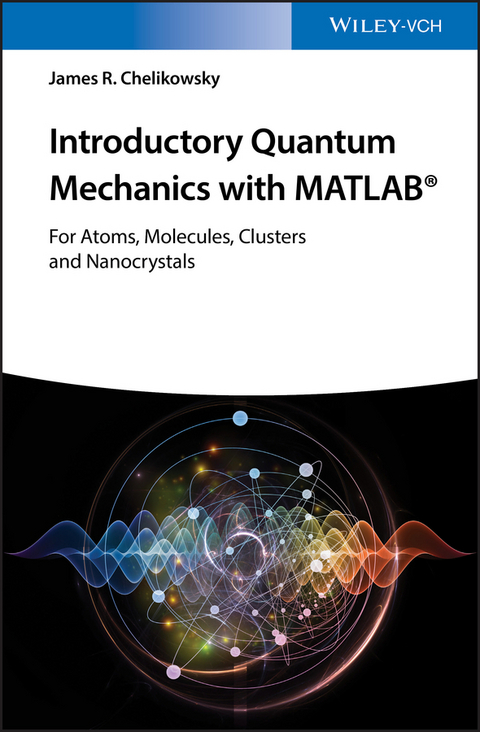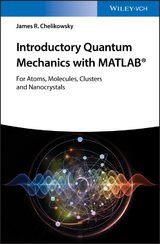Introductory Quantum Mechanics with MATLAB
Wiley-VCH (Verlag)
978-3-527-40926-6 (ISBN)
Presents a unique approach to grasping the concepts of quantum theory with a focus on atoms, clusters, and crystals.
Quantum theory of atoms and molecules is vitally important in molecular physics, materials science, nanoscience, solid state physics and many related fields. Introductory Quantum Mechanics with MATLAB is designed to be an accessible guide to quantum theory and its applications. The textbook uses the popular MATLAB programming language for the analytical and numerical solution of quantum mechanical problems, with a particular focus on clusters and assemblies of atoms.
The textbook is written by a noted researcher and expert on the topic who introduces density functional theory, variational calculus and other practice-proven methods for the solution of quantum-mechanical problems.
This important guide:
- Presents the material in a didactical manner to help students grasp the concepts and applications of quantum theory
- Covers a wealth of cutting-edge topics such as clusters, nanocrystals, transitions and organic molecules
- Offers MATLAB codes to solve real-life quantum mechanical problems
Written for master's and PhD students in physics, chemistry, material science, and engineering sciences, Introductory Quantum Mechanics with MATLAB contains an accessible approach to understanding the concepts of quantum theory applied to atoms, clusters, and crystals.
Der überaus erfahrene Autor füllt mit diesem Lehrbuch eine Lücke. Die Konzepte der Quantentheorie werden zugänglich und praxisorientiert präsentiert. Durch MATLAB-Codes lassen sich die beschriebenen numerischen Verfahren einfach umsetzen.
Hochaktuelle Themen wie Cluster, Nanokristalle, Übergänge und organische Moleküle, werden umfassend abgedeckt. DFT, Variation und verschiedene andere Methoden sowie Annäherungswellenfunktionen werden ebenfalls erläutert.
James Chelikowsky, PhD, is director of the center for computational materials at the University of Texas Austin. His research is centered on computational physics in materials science and the application of quantum theory to real materials.
Part 1 Theory
1 Introduction to quantum theory
2 One electron atoms
2.1 The Bohr atom
2.2 The Schrödinger equation
2.3 The electronic structure of atoms and the periodic table
3 Multi-electron systems: atoms and molecules
3.1 The variational principle
3.2 The Hartree approximation
3.3 The Hartree-Fock approximation
4 The electron gas
4.1 The free electron model
4.2 The Thomas-Fermi approximation
4.2 Exchange interactions
5 Density functional theory
5.1 The Hohenberg-Kohn-Sham Theory
5.2 The Kohn-Sham equation
6 Pseudopotential theory
Part 2 Numerical Methods
7 Methods for atoms
7.1 Variational methods
7.2 Integration methods
8 Methods for molecules and clusters
8.1 Basis set methods
8.2 Grid methods
8.3 Diagonalization methods
8.4 Filtering methods
9 MATLABR codes for atoms and molecules
Part 3 Applications
10 Atoms
10.1 Energy levels and orbitals
10.2 Ionization and affinity energies
10.3 Polarizabilities
11 Diatomic and Simple Molecues
11.1 Chemical trends and ionicity
11.2 Energy levels and orbitals
11.3 Binding energies and vibrational modes
12 Clusters
12.1 Special form of matter
12.2 The structure of clusters
12.2 Role of quantum confinement
12.2 Energy levels and orbitals
12.3 Binding energies and vibrational modes
Appendix
A Units
B Matlab codes
Bibliography
| Erscheint lt. Verlag | 7.11.2018 |
|---|---|
| Verlagsort | Berlin |
| Sprache | englisch |
| Maße | 170 x 244 mm |
| Gewicht | 432 g |
| Einbandart | kartoniert |
| Themenwelt | Naturwissenschaften ► Physik / Astronomie ► Quantenphysik |
| Naturwissenschaften ► Physik / Astronomie ► Theoretische Physik | |
| Schlagworte | Atomphysik • Chemie • Chemistry • Computational Chemistry & Molecular Modeling • Computational Chemistry u. Molecular Modeling • Electrical & Electronics Engineering • Elektrotechnik u. Elektronik • Festkörperphysik • MATLAB • MEMS • Physics • Physik • Quantenphysik u. Feldtheorie • Quantentheorie • Quantum Physics & Field Theory • Statistical Software / MATLAB • Statistics • Statistik • Statistiksoftware / MATLAB |
| ISBN-10 | 3-527-40926-2 / 3527409262 |
| ISBN-13 | 978-3-527-40926-6 / 9783527409266 |
| Zustand | Neuware |
| Informationen gemäß Produktsicherheitsverordnung (GPSR) | |
| Haben Sie eine Frage zum Produkt? |
aus dem Bereich





